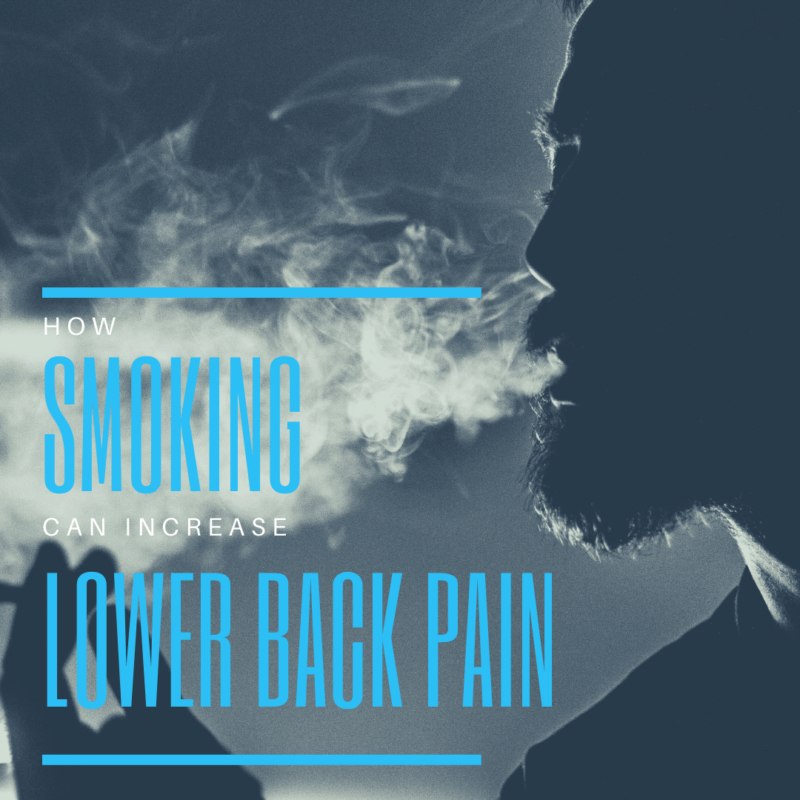Lower back pain is extremely common and is estimated to affect over 3 million Americans every year. One reason why lower back pain is so common is because there are a number of factors that can contribute to problems affecting the lower back. Some of these factors are out of your control, while others can be controlled. One example of a risk factor for lower back pain that can be controlled is smoking. Smoking causes a number of health problems and has been shown to contribute to lower back pain.

Although it has been postulated that smoking could have an effect on back pain, there were no long-term studies to support this theory. However, the findings of a 50 year long study were presented at the 2001 American Association of Orthopaedic Surgeons conference that supported the theory that smoking is a risk factor for lower back pain. Specifically, the theory postulated that smoking increases the risk of atherosclerosis, or diseased arteries filled with plaque and fatty material. The development of atherosclerosis, then damages the vascular structures of joints and discs, which eventually leads to lower back pain.
During this study, 1,337 physicians who graduated from John Hopkins University between 1948 and 1964 filled out self-reported questionnaires and granted researchers access to their medical records. Since the oldest patients were part of the study for around 53 years, this allowed researchers to gain more information on what types of health conditions can increase the risk for spinal problems later down the line. As the Chief Resident in the Department of Orthopedic Surgery at John Hopkins and co-author of the study, Nicholas U. Ahn puts it, “…we were able to determine the risk factors, such as smoking or high cholesterol, that preceded the development of the disease years later”.
What they found was that individuals who had a history of smoking and hypertension were significantly more likely to develop lower back pain. Those with a history of high cholesterol in addition to hypertension and smoking were also significantly more likely to develop lumbar spondylosis. Lumbar spondylosis is a fancy way of referring to degeneration in the spine. Although everyone will eventually experience spinal degeneration, lumbar spondylosis is a term that implies there is both degeneration and pain, regardless of the cause. There are various conditions that contribute to lumbar spondylosis, including: facet joint osteoarthritis, spinal stenosis, and degenerative disc disease to name a few.
How Smoking Can Increase Lower Back Pain
Now that we have reviewed the results of a long-term study on the relationship between smoking and lower back pain, let’s take a deeper look at just how smoking can contribute to lower back pain. For starters, tobacco products contain a variety of harmful ingredients that ultimately affect more than just your lungs. Here are some of the effects of smoking on the body, as well as how they can contribute to lower back pain:
Restricted Blood Flow
Nicotine is the primary ingredient that makes smoking so addictive, since it stimulates the reward center of the brain. However, nicotine also causes blood vessels to constrict, which reduces the amount of blood flow. Blood carries a variety of nutrients through the body and restricted blood flow minimizes the amount of nutrients that are able to circulate through the body. This can cause damage to the muscles and ligaments surrounding the spine, which increases the risk of early degeneration.
Increases Disc Degeneration
Another consequence of restricted blood flow is that the spinal discs do not receive enough necessary nutrients. Spinal discs are fluid-filled discs that sit between the vertebrae and allow for spinal flexibility and cushioning. Without enough nutrients, these discs will begin to break down, allowing bone to grind over bone.
Decreases Healing Ability
Smoking also causes chronic inflammation throughout the body, which causes the immune system to work harder. Unfortunately since the body is essentially under constant attack, the healing process slows down. This means that any damage done to the body takes longer to heal, which can make degenerative conditions worse. It also means that if you are receiving treatment for your back pain, you may be taking one step forward and two steps backwards. Additionally, the constant stress of being under attack changes the way your body functions and makes it more likely to be affected by disease.










